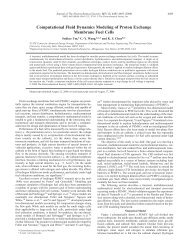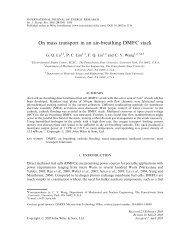Liquid Water Transport in Polymer Electrolyte Fuel Cells With Multi ...
Liquid Water Transport in Polymer Electrolyte Fuel Cells With Multi ...
Liquid Water Transport in Polymer Electrolyte Fuel Cells With Multi ...
- No tags were found...
You also want an ePaper? Increase the reach of your titles
YUMPU automatically turns print PDFs into web optimized ePapers that Google loves.
s<strong>in</strong>ce liquid pressure and water content is higher <strong>in</strong> the cathodeside of the membrane than the anode side. Therefore, with<strong>in</strong>creas<strong>in</strong>g current density, the electro-osmotic drag <strong>in</strong>creasesand starts to dom<strong>in</strong>ate over the convective and diffusivetransport of water across the membrane, result<strong>in</strong>g <strong>in</strong> <strong>in</strong>creas<strong>in</strong>gnet water transport coefficient with <strong>in</strong>creas<strong>in</strong>g current density.When cathode GDL is coated with MPL, it is seen that watertransport towards anode is significantly <strong>in</strong>creased and this<strong>in</strong>crease is clearly visible at the entire current density range.In Figure 4, the liquid pressure profiles <strong>in</strong> all fourconfigurations are shown at a current density of 0.1 A/cm 2 . Inthis current density, all four configurations result <strong>in</strong> two-phasetransport <strong>in</strong> both the anode and the cathode GDM. The <strong>in</strong>set ofthe figure shows the details of liquid pressure across themembrane. As stated above, the liquid pressure differentialacross the membrane is higher when anode GDL is hydrophilic.However, this difference becomes less significant whencathode GDL is coated with MPL. Due to its smaller pore size,MPL has much smaller permeability; therefore, liquid waterflow requires higher pressure differential across the MPL,<strong>in</strong>creas<strong>in</strong>g liquid pressure on the cathode side of the membrane.Here, the permeability of MPL is calculated from the follow<strong>in</strong>gexpression given by Rumpf and Gutte (Kaviany, 1995) forpacked beds with narrow range of distribution <strong>in</strong> size:5.52K = ε d(31)5.6where d is the average pore diameter. For an MPL of mean poresize of 1 µm and porosity of 0.5, this expression gives apermeability of 3.95·10 -15 m 2 , which is comparable withexperimentally measured values.Figure 5 shows the liquid saturation profiles <strong>in</strong> anode andcathode GDM at the same current density. It is seen that theliquid saturation <strong>in</strong> cathode GDL is decreased by use of anMPL due to decreased cathode water flux. It is also seen <strong>in</strong>cathode GDM, there is a discont<strong>in</strong>uity <strong>in</strong> the liquid saturationprofile at the GDL-MPL <strong>in</strong>terface. This discont<strong>in</strong>uity isgoverned by the cont<strong>in</strong>uity of phase pressures at this <strong>in</strong>terface.S<strong>in</strong>ce both gas and liquid pressures are cont<strong>in</strong>uous at this<strong>in</strong>terface, the capillary pressure is also cont<strong>in</strong>uous. Follow<strong>in</strong>gthe def<strong>in</strong>ition of capillary pressure <strong>in</strong> Eq. (13), one has thefollow<strong>in</strong>g relation for pressure cont<strong>in</strong>uity at the GDL-MPL<strong>in</strong>terface.GDL1 2MPL1 2GDL ⎛ ε ⎞GDLMPL ⎛ ε ⎞MPL( ) ⎜ ⎟ J ( s ) = cos( θ ) ⎜ J ( s )cos θcGDL <strong>in</strong>tcMPL <strong>in</strong>tK⎜ K ⎟ (32)⎜ ⎟⎝ ⎠⎝ ⎠It is clear that this discont<strong>in</strong>uity is a function of wett<strong>in</strong>gand porous characteristics of MPL and GDL, as well as theliquid flux <strong>in</strong> the cathode. Due to this discont<strong>in</strong>uity, liquidsaturation <strong>in</strong> cathode catalyst layer-GDM <strong>in</strong>terface may also besmaller than s<strong>in</strong>gle-layer configurations depend<strong>in</strong>g on themicro-structure of MPL; therefore catalyst layer flood<strong>in</strong>g canalso be reduced with MPL.It is also seen from Figure 5 that when hydrophilic GDL isused <strong>in</strong> anode, the liquid saturation <strong>in</strong> the anode GDL <strong>in</strong>creases,which is particularly due to smaller capillarity effects <strong>in</strong>hydrophilic GDL. It has been shown that capillary watertransport is stronger <strong>in</strong> hydrophobic GDLs than hydrophilicGDLs, particularly at lower liquid saturations (Pasaogullari andWang, 2004).Similar water transport characteristics that are observedwith MPLs can also be achieved by adjust<strong>in</strong>g the operat<strong>in</strong>gconditions, such as us<strong>in</strong>g higher cathode and lower anodepressures. Particularly, operat<strong>in</strong>g with pressure differentials hasbeen shown to significantly improve the performance (Voss etal., 1995, Jannsen and Overvelde, 2001, Beattie et al. 1999). Inall these examples, an <strong>in</strong>creased pressure differential across themembrane is formed to enhance the back-flux (i.e. towardsanode) of water, similar to what MPL causes.Effect of MPL ThicknessThe effect of the thickness of the MPL is analyzed us<strong>in</strong>gthe model expla<strong>in</strong>ed <strong>in</strong> the earlier sections. The parametersused for this case are the same as <strong>in</strong> Table 2, except that thethickness of the MPL is varied between 10 µm and 50 µm. Asseen <strong>in</strong> Figure 6, the net water transport coefficient is a strongfunction of MPL thickness. As the MPL thickness <strong>in</strong>creases,the net water transport coefficient curve shifts downwards<strong>in</strong>dicat<strong>in</strong>g that the water flux towards the anode is <strong>in</strong>creas<strong>in</strong>g.<strong>With</strong> <strong>in</strong>creas<strong>in</strong>g MPL thickness, the resistance to liquid waterflow <strong>in</strong> the cathode GDM <strong>in</strong>creases, and this <strong>in</strong>creasedresistance causes the fraction of water transported through themembrane towards anode to <strong>in</strong>crease, hence results <strong>in</strong> adecrease <strong>in</strong> cathode water flux. Inset of the Figure 6 shows thechange of net water transport coefficient with MPL thickness atseveral current densities. It is seen that the thickness of theMPL is particularly effective at lower current densities due tosmaller electro-osmotic drag flux.Effect of Mean Pore Size of MPLFigure 7 shows the net water transport coefficient acrossthe membrane for different mean pore sizes of MPL. Here, theproperties of the MPL are taken from the base case, which aregiven <strong>in</strong> Table 2 except for the mean pore size. The net watertransport curve shifts downwards with decreas<strong>in</strong>g mean poresize, <strong>in</strong>dicat<strong>in</strong>g <strong>in</strong>creas<strong>in</strong>g water flux towards anode. Thepermeability of MPL decreases with the pore size (see Eq.(31)), which <strong>in</strong>creases the resistance to water flow towardscathode channel. Therefore, water tends to flow <strong>in</strong> the pathwhich has smaller resistance, which <strong>in</strong> turn <strong>in</strong>creases the flowrate towards anode. This effect obviously is much more visible<strong>in</strong> lower current densities, where back-flux of water isdom<strong>in</strong>at<strong>in</strong>g over the electro-osmotic drag. As the currentdensity <strong>in</strong>creases, the electro-osmotic drag of water across themembrane becomes larger, dim<strong>in</strong>ish<strong>in</strong>g the effect of MPL. Asseen <strong>in</strong> the <strong>in</strong>set of Figure 7, the effect of the mean pore size ofMPL starts to disappear for larger pore sizes as the MPLpermeability becomes closer to GDL permeability. As theabsolute permeability is directly proportional to the square ofthe mean pore size (Eq. (31)), liquid pressure differential acrossthe MPL is magnified with decreas<strong>in</strong>g pore size. This <strong>in</strong>crease<strong>in</strong> the MPL pressure differential causes a higher pressuredifferential across the membrane, caus<strong>in</strong>g higher back-flux ofwater towards anode.It is evident that smaller pore size <strong>in</strong> MPL is <strong>in</strong>creas<strong>in</strong>g thetendency of liquid water flow towards anode. However,smallest pore size is probably not the optimal design, thus thegas phase transport will be hampered with the decreas<strong>in</strong>g poresizes. The gas-phase transport is most likely to be <strong>in</strong> theKnudsen regime <strong>in</strong> MPL due to the much smaller pore sizes. InKnudsen regime, the wall-to-molecule <strong>in</strong>teractions dom<strong>in</strong>atesover the molecule-to-molecule <strong>in</strong>teractions, and the pore sizebecomes the most important factor for gas diffusion. On the5 Copyright © 2004 by ASME




